#halifax mermaid
Explore tagged Tumblr posts
Text


I guess another 2 years have gone by since I've posted here.... Tumblr had kinda fallen to the way side.
I'm still incredibly active on my Twitter, insta and tiktok... however since covid kinda let up and people are back to our new normal lives, we'll I'm mostly active on Twitter. And posting occasionally on the other 2.
Nova is still my main sona, though I did buy back kyra the manokit! She is just kinda a trophy suit at this point 🤣
I'm still mermaiding with Halifax mermaids. Still have to many tails, though some have come and go. I have my own custom tails now! And gosh they are pretty.
My husband is in the military now, and we got posted and moved to a beautiful new city. Still up east in Canada.
Oh lol I don't think I ever posted but way back in 2020 I got married 😅 oops.
It's mostly funny to look back at my old posts here. They are almost a time capsule and diary. Maybe I'll treat it as such and keep checking in with life updates here every once in a blue moon.
Anyways. As always if your looking for me, find me @nova_fur everywhere other than here 🤣
3 notes
·
View notes
Text

Helena darling. Halifax Nova Scotia.
#helena darling#halifax#halifax tattoo#tattoo#inked#tattoo art#nova scotia#hfx tattoo#halifax art#nova scotia tattoo#mermaid#mermaid tattoo#colour tattoo
27 notes
·
View notes
Photo
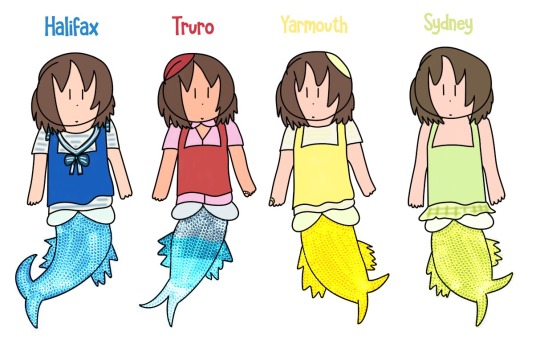
The Big Four Mermen of Nova Scotia! 🧜🏻♂️🧜🏻🌊⚓
#art#ask the nova scotians#nova scotia#atns: halifax#atns: truro#atns: yarmouth#atns: sydney#halifax#truro#yarmouth#sydney#mermen#merfolk#mermaids#mermay#mermay 2020
4 notes
·
View notes
Photo


After the success of my Nova Scotia mermaids and mermen, I just had to follow up with more merfolk from around the Maritimes. 🧜🏻♀️🧜🏻♂️🌊
#surfing the sea#canadian boys#canadian boys: fredericton#canadian boys: charlottetown#canadian boys: halifax#canadian boys: st. john's#fredericton#charlottetown#halifax#st. john's#canadian boys: saint john#canadian boys: moncton#saint john#moncton#mermay 2019#mermay#mermen#merfolk#merpeople#mermaids#maritimes#maritime provinces#atlantic canada#atlantic provinces#my art#surfingthesealand draws
8 notes
·
View notes
Photo

In love with this stunning photo from @hfxmermaid - thank you for including the Katrina Halo Crown in your incredible look! 💚💙💚 . . . . Don't be a drag, just be a Queen! 📷: @alteregohalifax 💄: @cassandracolours 👸: @elalanihair 👑: @apatico and @merbellastudios and @organicarmor 🧜: @mertailor ⭐: @sirenallure 🏃♂️: @merwrangler . Thanks to all involved in making this image! ♥️ #mermaid #raina #rainamertailor #rainamermaid #mermaidtail #queen #hfxmodel #hfxmermaids #hfxmermaid #halifax #apatico #mertailor #elalani #novascotia #canadiancreatives #realmermaid #siren #halo #halocrown #headpiece #fashion
#rainamermaid#fashion#elalani#halifax#novascotia#apatico#headpiece#siren#halocrown#rainamertailor#hfxmermaid#mermaid#mertailor#hfxmodel#realmermaid#queen#hfxmermaids#raina#mermaidtail#canadiancreatives#halo
4 notes
·
View notes
Text
Muse Moment
Stay in bed and have no plans on doing anything else. Reflect on life.
Just wake her up when December ends.
#I wanna get my tumbling active again#especially ivy#I miss my mermaid girl ;-;#ic#muse moment#aph halifax#event: halifax explosion
1 note
·
View note
Text

“My parents just liked the name. I didn’t find out it means ‘of the sea’ until I was like, 10 or something. Which is fun, because that’s also what my last name means! I’m like an aquatic Moon Moon! So, I kind of figured, hey, why not lean into it, you know? And ‘mermaid’ is a pretty rad aesthetic. Who doesn’t like rainbows and seashells?”
maris van der zee
age: 24
pronouns: she/her
from: halifax, nova scotia
studied: fine art
here for: the friendship, the adventure
has her eye on: florrie, griff, adegoke, syd, ellis, imogen, charlie
(from @bodycountgame)
51 notes
·
View notes
Text
Welcome to the second edition of i rate anne lister according to hotness in all of her scenes! PART I: here
Episode 2: “I Just Went There To Study Anatomy”
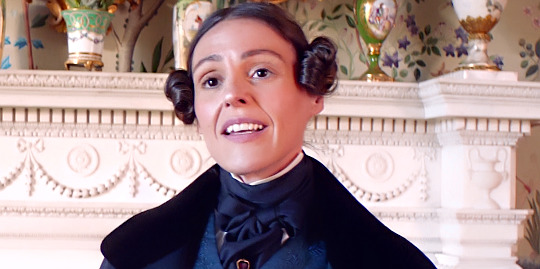
In The Process Of Making Wealthy Little Miss Walker Her Wife Anne: 10/10. This is a TRULY SUPERB Anne. This is peak dapperness. It’s one of her most polished looques -- the ear curls are gleaming, the eyebrow hair is tamed, the cravat is neat, the charm is on, she is so handsome that any woman would consider herself lucky to listen to her anecdotes about dissecting babies.
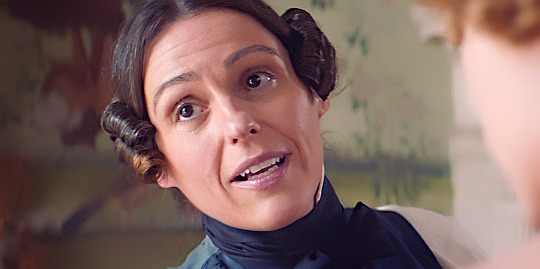
The Same Anne But She Has Taken Off Her Coat: 11/10 because Anne removing one of her 8687 layers of clothing is always sexy; extra bonus for the homoerotic tension and the close-ups of eyes and lips in this scene.

Dear Diary, All Miss Walker Needs To Do Now Is To Realise That What She Feels For Me Is Love Anne: 11/10. This is a fast-walking, self-satisfied, peacock-y Anne who moves so energetically that it is impossible to grab an unblurred screenshot of her. I am extra in love with this Anne because her boasting gets interrupted by a Bothersome Man and we see her morph from charming lesbian Anne into gruff business lesbian Anne. Hot.

Pondering One Of Many Coal Negotiations Anne: Ohohohhh definitely 14/10. The sleeves. The striped waistcoat. The ever so slightly dishevelled cravat. The intense gaze, the hand at her lips, the mermaid throne, this Anne has everything and can have all my coal and whatever other resources she demands of me. Wink wonk.
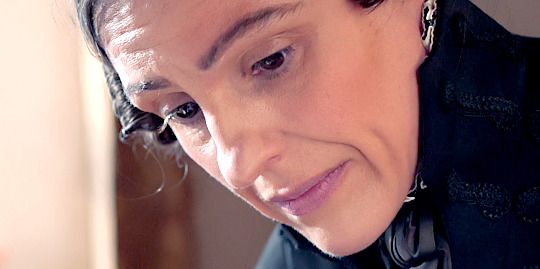
Doctor Anne Looking At Traumatised Farmboy: 8/10. This scene has a child in it and thus we aren’t meant to thirst for Anne quite as much, which I dislike. This Anne gets love from me for her very dark eyes and the fact that she talks about sword-fighting and discloses angsty insights into her psyche; though again, the dead brother and agony over being a lesbian who frequently gets mistaken for a man deflects a little bit from this Anne’s thirst-worthiness. Still a very beautiful and sweet Anne!

A Chaumière Is Not A Shed Anne: 12/10 I LOVE THIS ANNE. One of the most iconic Annes we ever did see! She is sassy and in charge, she bosses her family around, she does whatever she likes to her estate, she is snobby, she fingers her wine glass, she is conceited and snooty and looks EXACTLY like the kind of lady who runs the oldest house in Halifax, which dates back to Henry the Fifth and Agincourt and is not, and never has been, a farm, Marian.

Tempting Miss Walker To Go To Switzerland Anne: 11/10 A beautiful and hilarious Anne! An Anne who gets so jealous that she breaks a knife with her bare lesbian hands. An Anne who has her jealous lesbian wounds patched up by Miss Walker and her lily-white handkerchief, which is inherently sexy as fuck. Her cravat is silver, her collar is adequately ruffle-y, she is falling in love without quite realising it. A gorgeous, intense Anne. Would definitely go to Switzerland with her any day.
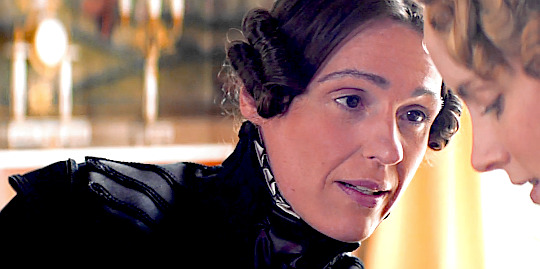
Wondering If Miss Walker Has Ever Kissed Anyone Anne: 15/10 because this scene has lip-stroking. And staring at lips. And longing. And ridiculous talk about sexual practices. This Anne is so focused in her courting of little Miss Walker and tbh who wouldn’t have a gay awakening under these circumstances??

Just Went To Paris To Study Anatomy Anne: 100000/10. I mean. I. I mean, I just, I mean, I, this, I just mean that this is. Yes. I. Hm. Apart from the obvious ........... the muscular arm. The loose hair that falls across her very naked back. The fact that she still has her drawers on because she is an untouchable stone butch. The glint of sunlight. Everything about this Anne and this scene is perfection.

Smirky Tophat Anne Who’s Having A Public Monologue On Her Own Greatness: 10/10 I LOVE to see a confident, happy Anne who wears a tophat and is fully aware of her own sexiness. Yes. Love love love. I want to wife this Anne.
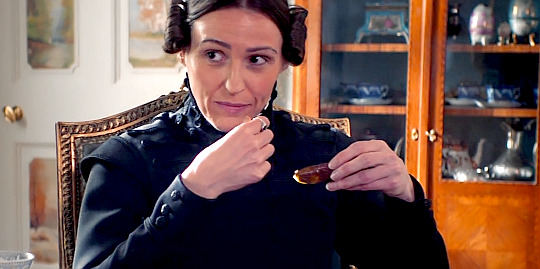
Eating Pieces Of Fruit In A Homosexual Manner Whilst Eyeing Up Mrs Priestley Anne: 12/10 I think we can all agree that the unnecessary way in which Anne spreads open slices of figs with her fingers and then buries her face in them for some delighted slurping is entirely hot and entirely stupid. And then she licks her thumb. And sucks on it. I appreciate this Anne but also kind of hate her.

About To Smash Her Room Because Vere Invited Her To Her Wedding Anne: 9/10. This Anne gets a lower rating just because my heart hurts when I watch this scene. Kudos to this angry, vulnerable, emotional Anne for realising she’s now Too Old to smash up her entire room because a lady is giving her trouble, though.

Confronting A Shitty Man At His Shitty Bank Anne: 10/10 This is a very Anne-y Anne. The hard stare, the tightly set jaw, the raised chin, the squared shoulders; this Anne embodies everything sexy about confronting shitty men in public and I just, oof. Also, look at her beautiful floral collar.
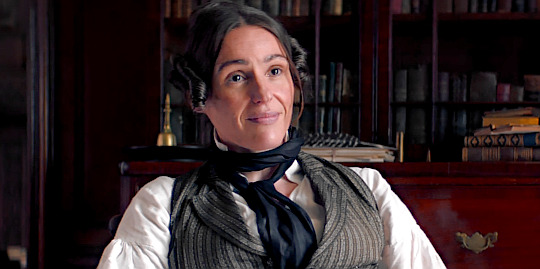
Laughing At A Shitty Man Anne: 16/10 This Anne has just returned back inside from doing manual labour in the garden (a scene I currently have no access to, fuck you HBO), and thus her cravat is undone, wisps of hair are flying everywhere, there are speckles of dirt in her face, she’s woman-spreading in her chair, you can see a sliver of her chest, and she’s wearing the biggest, most-shit eating Grin Of Self-Satisfaction in the world, and I love her, she is clearly the superior person in the room and also in the world. I want to sit on this Anne’s lap. Right now.

Saying Farewell To Ann Walker Whilst Admiring Her Watercolours Anne: 11/10 Ooohhh such a soft and lovely and sweet and romantic Anne. This is the first time she seeks emotional support from Ann, and you can see her melting ever so fondly as she falls further and further in love with her future wife. The gondola pin, the yearning, the closeness, the almost-kiss, it’s just too much. This Anne is so tender, but then she turns the room into a mosh pit as soon as A Possible Rival enters the scene. Shouldering Catherine out of the way? Sexy. Very.

Laughing At Yet Another Man Anne: 12/10 Listen I don’t know how many alpha Annes in a row I can stand, but this one is just hot, snarky, sarcastic, and so very prim and proper in her chair. Also, the sleeves. Goddess bless this Anne.
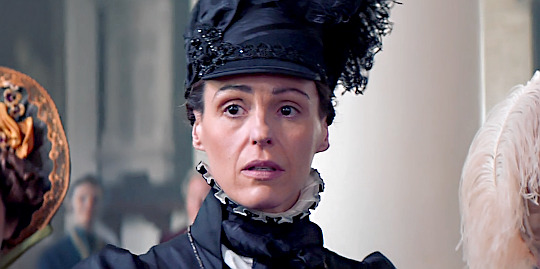
Wearing A Giant Hat That Makes Every Church-Goer Behind Her Erupt Into Spontaneous Hatred Anne: 20/10 This Anne is, despite her enormous monstrosity of a hat, just a wee tearful baby and I want to wrap her into the softest hug!! She is hot because this outfit is so positively ludicrous and only Suranne Jones could carry it off with so much confidence. But also, ouch, this scene hits me so hard because not only does Anne have to watch Vere get married to a man, she also ponders the fact that this sort of marriage will forever be denied to her, and it’s just ... not fair.
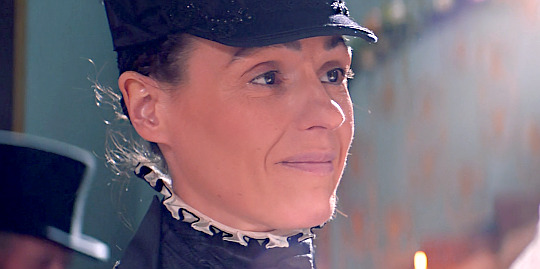
We’re Not Alive Unless We Tell Our Ex Girlfriend That Her Husband Sucks, Are We? Anne: 11/10 This is a very beautiful Anne. There is just a tiny bit of spite towards Vere’s husband (hot), but she prioritises kindness over her own heartbreak, and also you can see her little facial hairs glimmering in the slanting sunlight and she is an absolute lesbian angel. Also, I feel like this hat in close-up shots is the nearest we will ever get to a historical snapback-wearing Anne.

Off To Pester Miss Walker At The Lake District Anne: 50/10 THIS ANNE. This Anne is EVERYTHING! Look at her perfect stupid collar. Look at the puffy sleeves! Her watch is dangling around her neck! Her hair is adorable and braided very cutely! Her eyes are making love to the camera! Her smile waters my crops and also various other things of mine! She is happy to run after her wife, she focuses on the future instead of dwelling on the past, and she is absolutely breath-taking. Thank you Suranne Jones, you are a gift to lesbians everywhere in this universe.
Vote for your favourite Anne below!
#i dare to say i am like no one in the whole world. ( anne lister )#( long post. )#i wish to make a name for myself. ( headcanons )#( love love love love )
66 notes
·
View notes
Photo

Honestly, I belong in the ocean. Can I do a reverse Ariel and trade my legs for a fin? 🐬💕#Halifax #pointpleasantpark #mermaid #mermaidlife #ocean #webelongtothesea
2 notes
·
View notes
Photo

www.mermaidraina.com
43 notes
·
View notes
Photo

Helena darling. Darling tattoos. Halifax nova scotia.
#helena darling#inked#darling tattoo#halifax#halifax art#halifax tattoo#hfx#hrm#nova scotia#nova scotia tattoo#canada#canada art#canada tattoo#mermaid tattoo#mermaid#kawaii#kawaii tattoo#cute#cute tattoo#lady tattooers#inkluded#tattoodo#tattoo#skin deep#skin and ink#skin art#body art#mod
17 notes
·
View notes
Photo

Halifax: Hey, my fellow Maritime capitals are merfolk too! 🧜🏻♂️🧜🏻♀️🌊
#ask the nova scotians#nova scotia#halifax#atns: halifax#fredericton#charlottetown#st. john's#art#mermay#mermay 2019#merfolk#mermen#mermaids#merpeople#not nova scotia#maritimes#maritime provinces#atlantic canada#atlantic provinces
5 notes
·
View notes
Text
Summer 2021

Dear Friends, This is Theodore Too, being escorted to his berth at the Marine Museum in Kingston in July. You may recall, the popular children’s TV series in the 90s called Theodore Tugboat. Based on the exploits of a friendly little tug in a port loosely resembling Halifax, it aired in 80 countries around the world for seven seasons. Curious fact: Denny Doherty, formerly of the Mamas and the Papas, played the role of narrator and Theodore’s kindly Harbour Master. He also voiced all the animated characters, including Theodore. Denny was originally from Halifax. Theodore Tugboat was so popular that the TV producers commissioned a life-sized replica. Theodore Too was christened in Nova Scotia in 2000 and became an instant ambassador and fixture on the Halifax waterfront. Sadly, in 2020 Theodore’s owner was looking to sell. Happily, though, up stepped Blair McKeil of McKeil Marine in Burlington, Ontario. He and clean water advocacy group Swim, Drink, Fish came up with a new plan for Theodore. He would make the long voyage from Halifax to his new home in Hamilton Harbour. And from there he would take on the role of roving ambassador for clean water, green marine sustainability, and indigenous reconciliation, throughout the Great Lakes. Theodore’s arrival in Kingston for a two-day stay at the Marine Museum Pier was a hit with the pandemic-starved public. Over 2,000 visitors, mostly parents with young children, came to have their selfie moments with Theodore. There was more going on, though, than cartoon character entertainment. We held a formal welcoming ceremony on the Museum Pier to mark the occasion. In his role as emcee, the Museum Chair offered the following words. “The Marine Museum of the Great Lakes at Kingston acknowledges the site it sits on and the water it interacts with to be the traditional territory of First Nations peoples. We thank these Nations for their care and stewardship over this land and water. We are committed to sharing this stewardship moving forward. Today is an historic occasion in so many ways. I like to see it as a rebirth. It’s a rebirth for the Marine Museum. We haven’t had a public event of any kind down at this historic site for five years. This is a rebirth. We’re back! [loud applause] “This is of course a rebirth for Theodore Too, as he enters his new domain and new role as an ambassador for the environment of the Great Lakes. And as an ambassador for the often below-the-radar marine industry. Critically, it’s a rebirth for our relations with indigenous peoples and culture. We’re standing on what was traditionally known as Mississauga Point. From time immemorial this has been indigenous territory, land and water. We’re delighted to be reaching out – after far too long, I should say – to our indigenous partners. Among Theodore’s many new jobs, Swim, Drink, Fish has tasked him with collecting 100,000 ‘watermarks’. A ‘watermark’, I believe, is a personal reflection on one’s connection to these precious waters. For me, I connect with a daily swim in Lake Ontario. Not alone, but with a beautiful group of women called the Kingston Mermaids. Every morning from May 24 to Thanksgiving we gather for a 1 to 2 km swim, whatever the conditions. And every day we emerge from that swim communally reborn. That’s what these waters do for us. They give us life.” Happy summer to all, and wherever you are, may you enjoy the gift of life-giving waters! CW
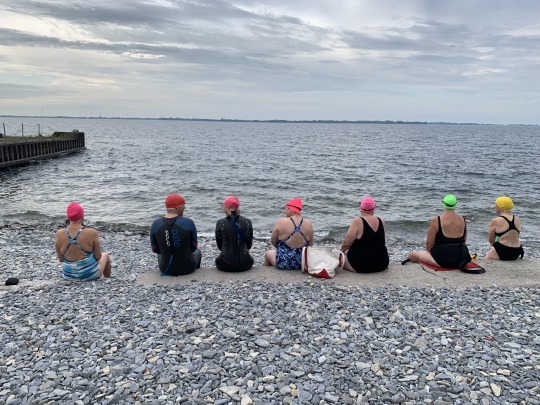
§ CLASS OF 2021 REPORT CARD Heroic returns driven by cash flows and profits To make a crude analogy, a stock company’s rising cash flows and profits are the life-giving waters that renew its fortunes, and enable it to be reborn for a new day, a new quarter, a new year, a new decade or longer. Conversely, absent these necessities, the opposite applies. Falling cash flows and profits, unless remedied, are the antithesis of continual rebirth. Rather, they signal inexorable decline, and takeover or extinction are looming threats. The Headmaster is delighted to observe that his students in the Class of 2021, almost without exception, delivered Olympian cash flow and profit growth over the past school year (July 1, 2020 to June 30, 2021). The Class average stock return reflected this heroic performance with an average gain of 31.9% for the 12-month period, vs. 29.9% for the TSX, 29.9% for the S&P 500 and 33.9% for the Dow. “Bravo!” exclaimed the Headmaster. “That’s two golds and a silver. I can hardly expect more.” Here are the sector by sector results. Financials - A+ After taking their knocks in 2020, Class members TD Bank, ScotiaBank, RBC and BlackRock came roaring out of the blocks in the past 12 months and posted an average gain of 45.9 %. Once again, BlackRock excelled, growing its assets under management to nearly $10 trillion and leading the Class with a return of 60.8%. The Headmaster, however, is not discounting the prospects for his Canadian trio: “With declining loan losses and surging earnings, the banks are swimming in excess cash. The bank regulator prudently halted dividend increases back in March 2020 to shore up bank capital reserves as we headed into the pandemic. But that policy will come to an end as we emerge from COVID. Expect mostly double digit dividend increases when it does. That will bode well for stock prices. All promoted.” Resources - A+ Global fertilizer and farm supplies retailer Nutrien caught the commodities wave and chalked up a 72.1% gain. Nutrien has the world’s largest reserves of low-cost potash, an essential farm crop nutrient, and is a major player in the other two essential fertilizers, nitrogen and phosphorus. Says the Headmaster: “It’s the nature of the beast that the fertilizer biz is highly cyclical and unpredictable. I can’t tell you what the price of soy beans will be next year, or whether weather will wipe out western wheat, or what card the inscrutable Chinese will play in the global potash market. However, I can tell you this: Nutrien, unlike its competitors, has a brilliant counterweight to that uncertainty ... its steady-Eddie farm supplies retailing unit. In consequence, Nutrien has become a dependable cash dispensing machine. Note the recent hike in the dividend and the announcement of yet another share buyback program. Promoted!” Energy - C+ As faithful readers will know, the Headmaster over the past three to four years has largely pulled the plug on fossil-fuel-related Class members. Goodbye Crescent Point. Goodbye Vermilion. Goodbye Enbridge. The two current claimants to the Energy bench are Algonquin Power and Brookfield Renewable Energy. Both are predominantly oriented to green energy and both are superbly well run businesses with exemplary long-term growth prospects, unlike their predecessors. Each has sailed through the pandemic with rising cash flows.
“That said,” adds the Headmaster, “Algonquin and Brookfield Renewables got a titch ahead of themselves in stock price and are currently taking a well-deserved rest. Their average stock gain over the school year was 3.4%. I am not deterred in the slightest. I expect renewed out-performance from this pair in the future. Promoted.”
Infrastructure - A Class stalwart Brookfield Infrastructure returned 23.1%. Headmaster: “Brookfield are masters at buying long-term assets with dependable, growing cash flows when they are out of favour and prices are low. Equally, they are adept at cashing out when greed enters the market and prices are high. Rinse and repeat.” Promoted.
Retail - B Classmate veterans Alimentation Couche-Tard and Metro, both hailing from Montreal, returned an average 6.5%. Couche-Tard, the global convenience store conglomerate (second in the world to Seven Eleven), and Metro, Canada’s best-run grocer are examples of companies that have benefited richly from pandemic stocking up and home meal preparation. Will their lustre fade as COVID recedes? Says the Headmaster: “That was not the case in the years before the pandemic and I see no reason why it will be so in the future. Both these companies excel in judicious investment of capital to grow profits and cash flow to the benefit of shareholders. I see no change in that trend. Promoted.”
Industry - A+ Says the Headmaster: “Label and packaging maker CCL, CNR and John Deere knocked it out of the park with an average gain of 62.9%. Bravo! And let’s give an extra pat on the back to John Deere, who cranked out an individual performance of 124.4%.” “Each of the members of this trio was well poised to benefit from COVID recovery, but there’s more to the story than that. Each is a superbly well-run business, primed to take advantage when opportunity knocks.” “For those who need reminding, John Deere is not just in the business of vending agricultural equipment and lawn mowers. It is also a major player in construction machinery and stands to benefit handsomely from the impending global infrastructure boom.” “There are those who doubt the wisdom of CNR’s bid to takeover Kansas City Southern Railway and integrate it into North America’s first and only railway system linking Mexico, the US and Canada. They have put the brakes on CNR’s stock of late. I happen to think they are wrong and should the deal go through, shareholders will be the beneficiaries for decades to come. Let us be patient.” All promoted.
Healthcare - B Healthcare, before the pandemic, during and no doubt after, tends to be seen as a ‘defensive’ sector. I.e., don’t look for spectacular growth or gains. Opines the Headmaster: “On the contrary, I see the singular cash generating qualities of these stocks through thick and thin -- our Merck, Amgen and Johnson and Johnson generate free cash flow of from 20 to 40% of sales -- as marvellously conducive to long-term wealth accumulation.” Early in June, Merck spun off its women’s health unit known as Organon. There was a share distribution to Merck stockholders. Given the slower growing nature of the spin-off, the Headmaster did not welcome Organon into the Class of 2022. He sold the shares and purchased more Merck. Merck, Amgen and J&J had an average return of 7.3% over the school year. Promoted.
Telecom - A The lone Class standard bearer for telecom continues to be Vancouver-based Telus. Telus, as a generator of healthy cash flows, has ploughed significant capital into its ‘fiber-to-home’ network in recent years, giving it a clear competitive advantage over chief western rival Shaw. Equally, Telus has invested in subsidiaries such as Telus International and Telus Health that are now yielding meaningful returns to the balance sheet. Headmaster: “Telus’s stock advanced a sprightly 22% over the school year. It still enjoys ‘best wireless network’ on most customer surveys, and consistently has Canada’s best customer retention rates. Promoted.”
Information Technology - A+ It is becoming a truth universally acknowledged that the info tech behemoths that rule so much of our lives are surprisingly impervious to the slings and arrows that beset the rest of the stock market. That was certainly the case for global giants and classmates Apple and Microsoft over the past year. They positively galloped through the pandemic. Visa is shrugging off a minor setback due to reduced international travel, and looks to have its groove back. Even domestic software player Open Text, a minnow by comparison with the other three, managed to keep cash flows and profits rising throughout COVID.
Headmaster: “This talented quartet had an average return of 28.3%. All promoted.”
Entertainment - A+ Disney, not surprisingly, took a COVID hit to several key sectors in its vast empire: theme parks, cruise ships and movie theatrical releases. However you wouldn’t know this from gazing upon its stock chart, up a remarkable 57.6% over the school year. The Headmaster has his thoughts on how this could be so: “We have to remind ourselves how huge and dominant this world-beater is. It doesn’t just own Pixar, Marvel, and Fox TV and movie studios. It also has Lucasfilm. So the Empire is always striking back. Not to mention that Disney also owns America’s largest and most profitable cable network, ESPN. And ABC. And the Disney Channel. The icing on the cake is that Disney appears to be well on the way to winning the streaming wars. Disney+, ESPN+ and Hulu and the like are on track to have 300 million subscribers by 2025. The only rival in its league looks to be Netflix. The two of them are divvying up the streaming world. Lastly, but not least, Disney has mastered the art of monetizing its franchises and their memorable characters across a myriad of platforms. It all began with Mickey Mouse. Now think of all those Elsas (from the movie Frozen) every Halloween. That’s the cash generating magic of Disney. Promoted!” If you would like further information on any of the investing ideas raised in this issue, or a complimentary consultation, please call or email.
CW
2 notes
·
View notes
Photo

The Original Mermaid
BY RAINA THE HALIFAX MERMAID
You could say that professional mermaiding began in 1904, when young Australian swimmer Annette Kellerman dove into a glass tank at the Melbourne Exhibition Hall and swam with eels and seals and tropical fish as a crowd gathered and her sister walked around with a hat. Nearly 50 years later, she would be immortalized by Esther Williams in Million Dollar Mermaid. Over a century later, when professional mermaiding is officially a thing, not only for me but for women and men all over the world, I look to her as my main inspiration. She was ground-breaking. And being the original mermaid was only the beginning.
Born in 1886 in Sydney, Kellerman was afflicted with a type of paralysis that kept her isolated and in leg braces until her doctor prescribed swimming as therapy when she was seven. She took joy in the little differences she noticed in her legs as she swam, and as her legs and fitness improved she began to swim competitively.
Kellerman’s family was finding it hard to make ends meet when she and her sister went to look for jobs at the local aquarium in Melbourne. Her sister joked that Kellerman should perform with the fish. Kellerman proposed the idea and was hired. Soon after she acquired a long glittery mermaid tail and earned the nickname “Mermaid.”
Read the article on about the first mermaid at EnchantedLivingMagazine.com
15 notes
·
View notes
Text
Kyle Hemmings — Notes on The Biography of E. H. Munch (3rd Edition)
1. A recurrent regret by Munch throughout his days is that he always felt he “skimmed the surface of life,” without ever taking the plunge into its depths, never explored its secret caverns and precious archaeologies, never gave himself over to “smiling mermaids who spoke a universal sign language with bubbles and sweeping hand motions that could never be imitated by land wishers”.
2. Munch was fond of misquoting Nietzsche. He believed in the philosopher’s view that the best time to die was when one was at the height of one’s powers. Munch said at parties, most likely as a joke, that he should have died at the age of ten.
3. The relationship with Hedda Grubber has frustrated many would be biographers and cultists. It is filled with gaps and inconsistencies. Salek recalls from an interview with Munch that he (Munch) had met her at a Parisian nightclub “where the air stung one’s nostrils with all varieties of rose and orchard scents mixed with the heavy smoke from Turkish cigarettes.” He claimed that the singer seduced him that night by stuffing her sequined underwear down his trousers. Inexperienced in all matters of love and conquest, Munch and the older Hedda made love “on rooftops, on deserted beaches at night, inside army tanks scheduled to be scrapped, inside the belly of a shrine to the Ghost of North Halifax.”
4. At the age of 95, Hedda denied much of what Munch revealed to journalists of the New Left. She did admit that Munch often trembled and remained silent for long periods of time after love making. When she asked him if anything was wrong, he gave his usual cryptic response, “Everything is wrong, Darling. The whole world is wrong and is in a downward spiral. I want to cry for everyone. But for the two of us, I will remain speechless. Perhaps we are all that matters.” They would then stay side by side in bed, holding hands in the darkness for hours, recalls Hedda.
5. As noted by Gremlich, Munch exhibited a fascination with lizards and snakes in his early sketches. He remarked that they represented “the crudest forms of politicians and bureaucrats”.
6. Hedda does recall the failed plot to assassinate Himmler much later and how several members of the Horst Brigade, including herself, helped to spring Munch from prison and to a safe passage to Switzerland. There, Hedda gave birth to a baby that didn’t live long, but Munch denied it was his. During his bouts of depression and mental cloudiness, he claimed that a young British spy posing as a Nazi officer was the real father and Hedda refused to speak to him for weeks. In a more lucid and serene state, he described Hedda to Salek as a cross between “a big-hearted prostitute with wings and a shadowy butterfly denying the death of flowers.”
7. “Try telling that fathead to behave himself before I knock his lights out,” was how Hedda often referred to Munch at all-night parties to the Dadaist, Martin Rou.
8. There are two contrasting versions of the incident at Goat’s Head View. According to Munch, he was staying that summer with a young British friend who had invited him. Munch claims that he was kneeling at the edge of a cliff overlooking a glittering sea when his host, the prankster, Marshall, climbed up the cliff and taunted Munch to pull him up. When Munch attempted to, Marshall let go, perhaps hoping that Munch would fall over. Instead, Marshall fell backwards and spent the rest of the summer in bed with two broken arms and one fractured leg.
Marshall’s version differs in that it claims that Munch was the one who was taunting, and always “full of clever little tricks.”
9. After the incident, Munch’s family moved him to an exclusive school on the continent where he excelled in languages and science.
10. Munch often said that he never left the “ravaged grounds of puberty” and always experienced an erotic obsession with woman having large breasts, curvy hips, a Cheshire smile, and a mercurial temperament.
13. What is being referred to here is the period of The Blank Canvas. Munch and Hedda decided to take a break from their tumultuous relationship. “So many broken eggshells with missing eggs and little white lies turning monstrous and black,” recalls Hedda. Actually, The Blank Canvas Period lasted roughly about seven months. During this time, Munch painted little, and cavorted with the amorous Hollywood starlet, Wanda Thrush, a one-time fling of Fritz Lang, although the latter denied it. Munch summarized the period as “a beautiful way to deny the emptiness of last night’s hangover.” Thrush later took up with the writer/safari hunter–Hugo Dietsch. Both she and an inexperienced guide were mauled to death by a lion. Dietsch was later killed by a Spanish bullfighter whose estranged wife the actor was romancing and were seen together swimming nude in the sea .
14. Hedda was known to take her martinis with three olives “standing straight up”.
15. The years between 1948 and 1964 were the most productive for Munch, art-wise. It was during this period that he developed his Red Lady series of semi-abstract paintings. Munch had become fascinated with the “emotional properties” of red and blue, with gradations of yellow thrown in. Most of the pieces have an abstract background composed of blue and red swirls and in the foreground, a faceless woman dressed in flapper hat, short fringe dress, and holding a cane, a la cabaret style. Art critics remarked that the red mostly likely symbolized the blood that later Munch obsessed over to such a degree that he painted skies and clouds streaked with it, until right before his institutionalization at Geneva, when he painted huge red balls against a dark canvas, perhaps symbolizing for him not only his ensuing blindness, but also, the end of the world.
16. Roughly five weeks after his release from Saint Morgan’s, Munch, as noted by the increasingly brittle Hedda, seemed to be at peace with himself. However, after an argument in which Hedda accused him of “killing our baby,” even though Hedda had not given birth in over 38 years, Munch retreated into his study and shot himself with a revolver. The same one he intended to use on Himmler, many years before.
In her memoir, Hedda reconstructs this incident by stating that by “our baby” she meant the book of poems and paintings that she and Munch had been working on and off for years. She claimed that in a fit of rage and frustration, Munch had torn up the drafts, flinging them outside their Paris window, calling them “worthless birds.” He then fell into her arms and sobbed uncontrollably until he fell asleep. The next morning, Hedda found him dead from a gunshot wound, in the study.
17. Hedda later moved to Norway, lived the rest of her life alone, and maintains in her memoir that Munch was the only man she ever truly loved, despite her numerous affairs with late Dadaists and young college students whom she taught as an associate professor of Modern Literature. She was later buried alongside Munch at a small cemetery in Bavaria. Wallach notes that “visitors claim they can hear them both dreaming of the other through closed caskets.”
18. Translation: They must dream loudly.
X
1 note
·
View note
Text
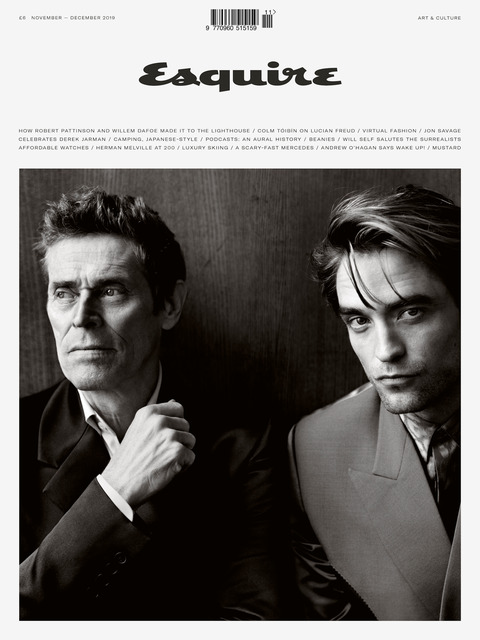
How Robert Pattinson And Willem Dafoe Made It To The Lighthouse
Out of a swirling fog emerges the prow of a boat, knifing through a foaming sea. Two figures, shadows in the murk, stand silhouetted on the foredeck, confronting the horizon, their backs to us. Presently an island swims into view. No more than a crag, really: lonely, battered, forbidding. Then a lighthouse can be made out, blinking in the gloom.
Now we see the men head-on, a striking dual portrait in high contrast black and white: a double exposure. They are wearing sailors’ caps, greatcoats, and hefting wooden trunks. One is younger, taller, moustachioed. The other, more deeply crevassed, sports a wild beard, out of which pokes a small wooden pipe, like Popeye’s. Theirs are, by any standards, remarkable faces, extreme faces, unyielding as rock yet sculpted with great delicacy, skin stretched tight over jutting bones: sharp noses, strong jaws, deep set eyes. And, oh, the cheekbones! And would you look at all those teeth?
Before anything else — before they are handsome faces, or expressive faces, or famous faces (they are all of those things) — these are photogenic faces. On first inspection they appear impassive, almost blank. And yet an air of foreboding is struck. The older man’s features are fixed in a roguish grimace. The younger man is wary, tense. These might be the faces of a father and son, or brothers separated by decades: hard, thin, stern faces, built for hard, thin, stern lives. Lives filled with mean disappointments, festering resentments, blood feuds. Here are men who have seen trouble before and will see it again. Maybe they’re looking for trouble. Maybe they’ve found it. Is this a dual portrait — or the portrait of a duel?
Whatever has thrown these men together in this place — fate, karma, the thirst for adventure, the desire for escape (in the case of the characters, but perhaps the actors, too?) or (in the case of the actors specifically) the need to stretch oneself artistically, or to challenge oneself physically, or the reputation of the director, or a really good script, or all of these things — one senses they are aware already, as they square up to the stinging reality of their circumstances, that they may have got more than they bargained for. What we can be sure of from the off: there will be weather. There will be conflict. And there will be acting.
The film is The Lighthouse, the second feature film from the 36-year-old American writer-director Robert Eggers, who made a stir with his debut, The Witch. Eggers, who is based in Brooklyn but grew up in rural New Hampshire, is a man possessed of a rare and creepy gothic sensibility. The Witch was an arthouse horror film, a twisted fairytale with the insidious power of a nightmare. It concerned a family of 17th-century puritans banished to the woods of New England, and it involved possessed children, birds pecking at human flesh, and an unholy bond with a goat. It cost $4m to make and earned that money back 10 times over, making Eggers not just a critical darling, but a coming man in commercial cinema.
For The Lighthouse, Eggers is reunited with A24, among other production companies, and with much of his crew from The Witch, including his director of photography, Jarin Blaschke, and composer Mark Korven, who between them do as much as anyone to set the eerie mood. His co-writer is his brother, Max Eggers. The actors were new to him.
Those faces that I have been at pains to describe, then, belong to Robert Pattinson and Willem Dafoe. They play lighthouse keepers on a wind-slapped, rain-lashed rock off the Atlantic coast of North America. The year is 1890. Pattinson is, or appears to be, Ephraim Winslow, the taciturn apprentice. “I ain’t much for talkin’,” he says early on — a statement, like so many in this film of shifting and unfixed identities, that turns out to be not entirely true.
Dafoe is Winslow’s irascible, peg-legged senior partner, Thomas Wake, an experienced “wickie” and a cruel taskmaster, obsessively enraptured by the beacon he tends. “The light is mine!” he declares, mad-eyed. Wake consigns Winslow to the bowels of the building, where the younger man stokes the fire and swabs the floors and nurtures his grievances, while indulging in some quite epic, mermaid-focussed masturbation. Winslow and Wake are to spend four weeks alone on the island before they are to be relieved. But when a storm blows in, the odd couple are stranded — maybe, or maybe not, because a violent act on Winslow’s part has brought down a curse upon them. Slowly, and then in spasms of ultraviolence, they unravel.
The Lighthouse is a twisted buddy movie, a surreal black comedy, a psychological thriller set at the hysterical pitch of Grand Guignol. It was filmed in the spring of 2018 on sound stages in the city of Halifax, Nova Scotia, on Canada’s Atlantic coast, and on location on the tiny fishing community of Cape Forchu, nearby. (“People tend to spend up to 45 minutes here,” Google Maps tells us of Cape Forchu. This fact might, or might not, amuse the filmmakers who spent weeks there, battling Biblical conditions. “It snowed in May,” notes Dafoe.)
With the exception of the Moldovan model Valeriia Karaman, who makes a number of brief, though memorable, appearances in her debut film, Pattinson and Dafoe are the only members of the cast, and their seesawing power struggle is the film’s entire focus, with point of view switching sides like a sail boat’s boom in a storm. Its success or failure rests heavily on their shoulders.
Pattinson and Dafoe are big stars, both. They are also men from different generations, different backgrounds, different countries and traditions. The Lighthouse was not an easy film to make for a number of reasons — the remote location, the raging weather — but not the least of the filmmakers’ challenges were the contrasting approaches of the two actors.
“They really did have incredible chemistry on screen,” director Eggers tells me on the phone, “but it was chemistry through tension. I know there’s been discussion about their different acting techniques and the trying conditions on set…” He pauses. “That couldn’t have been better for the movie.”
If you happened to be out and about in Halifax, in the early spring of 2018, you may have noticed a slender young loner stalking the streets day after day, muttering to himself. Noticed him, and felt concern for his emotional wellbeing. Had you followed him, and listened closely, you might have heard the same words repeated over and over again, in a gravel-voiced near-grunt: “Woyt poyn, woyt poyn, woyt poyn…” Come again? “Woyt poyn, woyt poyn...”
“White pine,” the slender young man enunciates into my voice recorder, 18 months on, in the accent of a nicely brought-up southwest London boy, rather than a 19th-century working man from a highly specific part of Maine. White pine — I’m sorry, woyt poyn — is one of the trees which his character lists when telling his colleague of his past misadventures as a lumberjack. Pattinson developed the accent with the help of a dialect coach and by speaking to a contemporary Maine lobster fisherman on the phone. “It’s one of those accents where if you say one syllable wrong it’s suddenly Jamaican, or something,” he says. “So it took ages.”
Pattinson arrived early in Halifax, before his director and co-star, to psych himself into the role of the saturnine Ephraim. Having approached Eggers after seeing The Witch, in the hope that they might at some point work together, Pattinson had declined the director’s first suggestion, for a part in a more conventional, mainstream film that the director was then developing.
“He said he was only interested in doing weird things,” Eggers says. “So when The Lighthouse came around I said that if he doesn’t find this weird enough, I guess we’ll never work together.”
It’s true, Pattinson says, that at that time, in 2016, he “wanted to do the weirdest stuff in the world.” (Mission accomplished, Rob!) Still, he spent a good deal of time agonising over whether or not to take the role in The Lighthouse. “I remember reading it and I thought it was very funny, but I was also thinking, ‘I don’t understand how the tone would work?’”
When Dafoe signed on, Pattinson was excited. “I knew Willem could bring that kind of anarchic energy,” he says, “but I really didn’t know how I would do it at all.” Dafoe, he says, in one of his many moments of self-effacement, “has one of those faces where he can literally sit in any room in the world, doing almost nothing, and it’s fascinating to watch. Whereas I sort of blend in with the chair I’m sitting on.”
Before filming began, the pair spent a week in rehearsals. Pattinson dislikes rehearsing, preferring to do his experimenting on camera. “It was very, very frustrating,” he says. “I just couldn’t achieve what they wanted me to achieve in that room. Robert [Eggers] was getting furious with me because I was just sitting there, completely monotone the whole time. He could not stand it.” Pattinson tells the story with no rancour whatsoever. He knows it sounds funny, but it wasn’t at the time. “I just don’t know how to perform it until we’re performing it. By the end of the week, I’m thinking, ‘I’m going to get fired before we’ve even started’. I definitely feel like, with the rehearsal period, we were quite angry with each other by the end of it. Literally, we’d finish for the day, I’d fucking slam out the door and go home.
“I knew that there was diminishing expectations of me throughout the week of rehearsals,” he says. “I definitely became an underdog. They’re like, ‘Wow, this was a big mistake. He’s really shit.’”
Pattinson and I talk on a sweltering August morning, in the comfort of a private members’ club in west London, near the flat he’s rented for the summer on Airbnb. (He’s in town to shoot Christopher Nolan’s new sci-fi spectacular, Tenet, about which he is permitted to tell us, with fulsome apologies, precisely nothing.) Rather than swigging kerosene and chaining tobacco, as in the film, he orders a banana smoothie, and when he’s finished that, an apple juice. Occasionally he sucks on a Juul.
Pattinson is 33. He grew up in affluent Barnes, the son of a dealer in vintage cars and a model booker. More or less untrained — unless you count some teenage am-dram — at 19 he was cast as Cedric Diggory, the hero’s doomed frenemy, in Harry Potter and the Goblet of Fire. But his Hollywood breakthrough arrived in 2008. Twilight was a teen B-movie, but it became a pop cult phenomenon, spawning four sequels of diminishing charm, making an otherworldly $3.3bn worldwide and creating megastars of its leads, Pattinson, who played a sexy vampire, and Kristen Stewart, who became his girlfriend on screen and IRL, as they say, before, in an unseemly frenzy of prurient salivating, she became his ex-girlfriend.
While for some he may always be the pallid tween heartthrob, in the six years since the final instalment of Twilight, Pattinson has worked hard to reinvent himself. His post Young Adult years have been cussedly uncommercial and impressively adventurous. In that period, Pattinson has worked with some of cinema’s most fêted directors: David Cronenberg, Anton Corbijn, James Gray, Werner Herzog, the Safdie brothers. Most recently, he was an intergalactic castaway in High Life, an enjoyable, if bonkers, dystopian sci-fi from the French director Claire Denis.
“Even in the Twilight years I never said, ‘Oh, he’s just a pretty boy,’” says Robert Eggers. “I always thought there was something interesting about him. I could tell that he wanted to be a great actor. And in the past years it’s been very clear that he is.”
The attraction of more avant garde or outré material, Pattinson says, is it allows him to let rip in a way he never could in real life. Pattinson compares the experience of acting in a film like The Lighthouse with joyriding. “A lot of the movies I’ve done recently, you literally feel as if you’ve stolen a car and you’re kind of careening through stuff.” (Such are the fantasies, perhaps, of a boy who grew up with a father who imported American sports cars for a living.)
In person, Pattinson is a mild-mannered English actor, albeit a slightly eccentric one. On set, however, “because you’re playing a mad person, it means you can sort of be mad the whole time. Well, not the whole time, but for like an hour before the scene.”
What does he mean by being mad? “You can literally just be sitting on the floor growling and licking up puddles of mud.”
This sounds figurative. He really means it. On The Lighthouse, in the scenes in which his character is meant to be drunk on kerosene (there are quite a few of them), he was “basically unconscious the whole time. It was crazy. I spent so much time making myself throw up. Pissing my pants. It’s the most revolting thing. I don’t know, maybe it’s really annoying.”
It’s hard not to speculate that yes, it might be really annoying. “There’s a scene,” Pattinson remembers, “where Willem’s kind of sleeping on me and we’re really, really drunk and I felt like we’re completely lost in the scene and I’m sitting there trying to make myself gag and Robert [Eggers] told me off because Willem’s looking at him going: ‘If he throws up on me, I’m leaving the set.’ I had absolutely no idea this whole drama was unfolding.”
In some ways, Pattinson concedes, all this acting out is a reaction to his terrifying early super-fame. He speaks of himself in the second person when talking about it. “For a long time you’re very self-conscious in the street. You’re hiding a lot, so [on set] you have an excuse to be wild. It’s like being an adrenaline junkie. And also, when you don’t know how to do something, why not just run headfirst into a wall? See what happens. I haven’t got any other ideas.”
On The Lighthouse, he spun in circles before each take, to make himself off-balance. He placed a stone in one of his shoes, to increase the already considerable physical hardship. He can see — from my disbelieving laughter, apart from anything else — that all this strikes non-actors as funny, even preposterous. It may be that it sounds this way to some actors, too.
The most famous story (possibly apocryphal) of an encounter between an adherent of the Method — in which actors don’t so much pretend to be someone else as try to temporarily become them — and a more traditional, outside-in actor, who puts on costume and makes believe, is Laurence Olivier’s withering put-down of Dustin Hoffman, when they were working together on John Schlesinger’s Marathon Man. At some point, Hoffman, a graduate of the Actors Studio, confided in the great English Shakespearean that, in order to bring the correct verisimilitude to a scene in which his character has not slept for three consecutive nights, he had forced himself to stay awake for the same period. “My dear boy,” Olivier is said to have smoothly replied, “why don’t you just try acting?”
Eggers says that any suggestion of that kind of relationship between Dafoe and Pattinson is wide of the mark. “The idea that Dafoe is outside-in and Rob is this method actor, that’s not the case. I think maybe they lean the tiniest bit into those directions but they’re both combinations of things.”
ESQUIRE: https://www.esquire.com/uk/culture/a29300396/robert-pattinson-willem-dafoe-interview/
90 notes
·
View notes